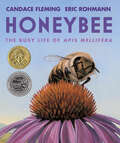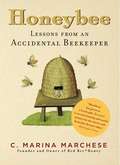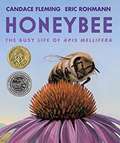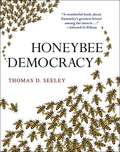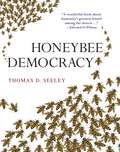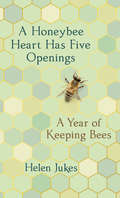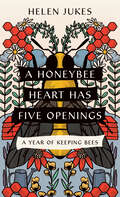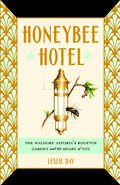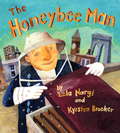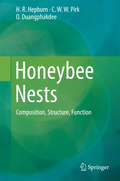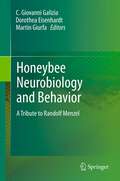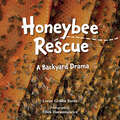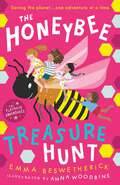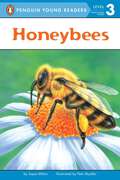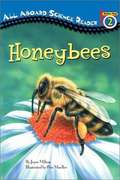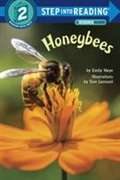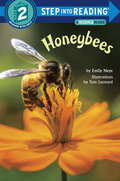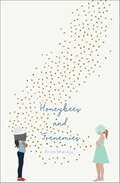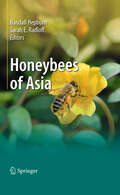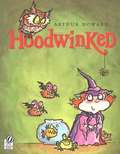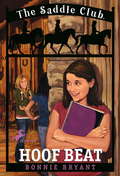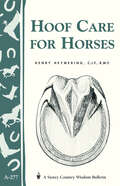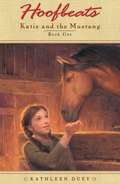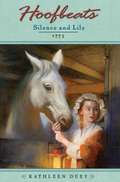- Table View
- List View
Honeybee: The Busy Life of Apis Mellifera
by Candace FlemingRobert F. Sibert Medal Winner Take to the sky with Apis, one honeybee, as she embarks on her journey through life!An Orbis Pictus Honor BookSelected for the Texas Bluebonnnet Master ListFinalist for the AAAS/Subaru SB&F Prize for Excellence in Science Books A tiny honeybee emerges through the wax cap of her cell. Driven to protect and take care of her hive, she cleans the nursery and feeds the larvae and the queen. But is she strong enough to fly? Not yet! Apis builds wax comb to store honey, and transfers pollen from other bees into the storage. She defends the hive from invaders. And finally, she begins her new life as an adventurer. The confining walls of the hive fall away as Apis takes to the air, finally free, in a brilliant double-gatefold illustration where the clear blue sky is full of promise-- and the wings of dozens of honeybees, heading out in search of nectar to bring back to the hive. Eric Rohmann's exquisitely detailed illustrations bring the great outdoors into your hands in this poetically written tribute to the hardworking honeybee. Award-winning author Candace Fleming describes the life cycle of the honeybee in accessible, beautiful language. Similar in form and concept to the Sibert and Orbis Pictus award book Giant Squid, Honeybee also features a stunning gatefold and an essay on the plight of honeybees.Cook Prize Honor BookA Kids' Book Choice Award FinalistAn American Library Association Notable Children&’s BookA New York Public Library Best Book of the YearNamed a Best Book of the Year by Kirkus Reviews, NPR, Shelf Awareness, School Library Journal, Publishers Weekly and more!A Horn Book Fanfare Best Book of the YearA Bank Street Best Children's Book of the Year!A Bulletin of the Center for Children's Books Blue Ribbon BookA Booklist Editor's ChoiceNamed to the Texas Topaz Reading ListA Junior Library Guild Gold Standard Selection
Honeybee: Lessons from an Accidental Beekeeper
by C. Marina MarcheseNow in paperback, Marina Marchese's inspirational and practical story of learning to raise honeybees and creating a life she loves "[An] engaging, delightfully informative work?" ?Publishers Weekly "Marchese has given us a lovely gift. Honeybee is an entertaining and useful primer for the novice and honeybee devotee alike." ?Washington Times "Surpassing the predictable "how I changed careers" memoir of finding the good life, Marchese's informative guide is packed with facts about everything from pollination to harvesting, life cycles to historical lore, nutritional benefits to gourmet flavor combinations, medical applications to unusual varieties." ?BooklistIn 1999, Marina Marchese fell in love with bees during a tour of a neighbor's honeybee hives. She quit her job, acquired her own bees, built her own hives, harvested honey, earned a certificate in apitherapy, studied wine tasting in order to transfer those skills to honey tasting, and eventually opened her own honey business. Today, Red Bee® Honey sells artisanal honey and honey-related products to shops and restaurants all over the country. More than an inspiring story of one woman's transformative relationship with honeybees (some of nature's most fascinating creatures), Honeybee is also bursting with information about all aspects of bees, beekeeping, and honey?including life inside the hive; the role of the queen, workers, and drones; pollination and its importance to sustaining all life; the culinary pleasures of honey; hiving and keeping honeybees; the ancient practice of apitherapy, or healing with honey, pollen, and bee venom; and much more. Recipes for food and personal care products appear throughout. Also included is an excellent, one-of-a-kind appendix that lists 75 different honey varietals, with information on provenance, tasting notes, and food-and-wine pairings.
Honeybee The Busy Life of Apis Mellifera: The Busy Life Of Apis Mellifera
by Candace FlemingThe life cycle of a honeybee is explained in this book.
Honeybee Democracy
by Thomas D. SeeleyHoneybees make decisions collectively--and democratically. Every year, faced with the life-or-death problem of choosing and traveling to a new home, honeybees stake everything on a process that includes collective fact-finding, vigorous debate, and consensus building. In fact, as world-renowned animal behaviorist Thomas Seeley reveals, these incredible insects have much to teach us when it comes to collective wisdom and effective decision making. A remarkable and richly illustrated account of scientific discovery, Honeybee Democracy brings together, for the first time, decades of Seeley's pioneering research to tell the amazing story of house hunting and democratic debate among the honeybees. In the late spring and early summer, as a bee colony becomes overcrowded, a third of the hive stays behind and rears a new queen, while a swarm of thousands departs with the old queen to produce a daughter colony. Seeley describes how these bees evaluate potential nest sites, advertise their discoveries to one another, engage in open deliberation, choose a final site, and navigate together--as a swirling cloud of bees--to their new home. Seeley investigates how evolution has honed the decision-making methods of honeybees over millions of years, and he considers similarities between the ways that bee swarms and primate brains process information. He concludes that what works well for bees can also work well for people: any decision-making group should consist of individuals with shared interests and mutual respect, a leader's influence should be minimized, debate should be relied upon, diverse solutions should be sought, and the majority should be counted on for a dependable resolution. An impressive exploration of animal behavior, Honeybee Democracy shows that decision-making groups, whether honeybee or human, can be smarter than even the smartest individuals in them.
Honeybee Democracy
by Thomas D. SeeleyHow honeybees make collective decisions—and what we can learn from this amazing democratic processHoneybees make decisions collectively—and democratically. Every year, faced with the life-or-death problem of choosing and traveling to a new home, honeybees stake everything on a process that includes collective fact-finding, vigorous debate, and consensus building. In fact, as world-renowned animal behaviorist Thomas Seeley reveals, these incredible insects have much to teach us when it comes to collective wisdom and effective decision making. A remarkable and richly illustrated account of scientific discovery, Honeybee Democracy brings together, for the first time, decades of Seeley's pioneering research to tell the amazing story of house hunting and democratic debate among the honeybees.In the late spring and early summer, as a bee colony becomes overcrowded, a third of the hive stays behind and rears a new queen, while a swarm of thousands departs with the old queen to produce a daughter colony. Seeley describes how these bees evaluate potential nest sites, advertise their discoveries to one another, engage in open deliberation, choose a final site, and navigate together—as a swirling cloud of bees—to their new home. Seeley investigates how evolution has honed the decision-making methods of honeybees over millions of years, and he considers similarities between the ways that bee swarms and primate brains process information. He concludes that what works well for bees can also work well for people: any decision-making group should consist of individuals with shared interests and mutual respect, a leader's influence should be minimized, debate should be relied upon, diverse solutions should be sought, and the majority should be counted on for a dependable resolution.An impressive exploration of animal behavior, Honeybee Democracy shows that decision-making groups, whether honeybee or human, can be smarter than even the smartest individuals in them.
A Honeybee Heart Has Five Openings: A Year of Keeping Bees
by Helen JukesAn inspiring, up-close portrait of tending to a honeybee hive—a year of living dangerously—watching and capturing the wondrous, complex universe of honeybees and learning an altogether different way of being in the world."As strange, beautiful, and unexpected, as precise and exquisite in its movings as bees in a hive. I loved it."--Helen Macdonald, author of H Is for Hawk A Honeybee Heart Has Five Openings begins as the author is entering her thirties and feeling disconnected in her life. Uneasy about her future and struggling to settle into her new house in Oxford with its own small garden, she is brought back to a time of accompanying a friend in London—a beekeeper—on his hive visits. And as a gesture of good fortune for her new life, she is given a colony of honeybees. According to folklore, a colony, freely given, brings good luck, and Helen Jules embarks on a rewarding, perilous journey of becoming a beekeeper. Jukes writes about what it means to &“keep&” wild creatures; on how to live alongside beings whose laws and logic are so different from our own . . . She delves into the history of beekeeping and writes about discovering the ancient, haunting, sometimes disturbing relationship between keeper and bee, human and wild thing. A Honeybee Heart Has Five Openings is a book of observation, of the irrepressible wildness of these fascinating creatures, of the ways they seem to evade our categories each time we attempt to define them. Are they wild or domestic? Individual or collective? Is honey an animal product or is it plant-based? As the author&’s colony grows, the questions that have, at first compelled her interest to fade away, and the inbetweenness, the unsettledness of honeybees call for a different kind of questioning, of consideration. A subtle yet urgent mediation on uncertainty and hope, on solitude and friendship, on feelings of restlessness and on home; on how we might better know ourselves. A book that shows us how to be alert to the large and small creatures that flit between and among us and that urge us to learn from this vital force so necessary to be continuation of life on planet Earth.
A Honeybee Heart Has Five Openings: A Year of Keeping Bees
by Helen JukesA Honeybee Heart Has Five Openings begins as Helen Jukes is entering her thirties and struggling to settle into her new job and home. Then friends gift her a colony of honeybees—a gift that, according to folklore, brings good luck—and Jukes embarks on the rewarding, perilous journey of becoming a beekeeper.Jukes writes about what it means to "keep" wild creatures and to live alongside beings whose laws of life are so different from our own. She delves into the history of beekeeping, exploring the ancient—and sometimes disturbing—relationship between keeper and bee, human and wild thing. And as her colony grows, the very act of beekeeping seems to open new perspectives, making her world come alive again. A beautifully wrought meditation on uncertainty and hope, feelings of restlessness and home, and how we might better know ourselves, A Honeybee Heart Has Five Openings shows us how to be alert to these small creatures flitting among us that are yet so vital a force for the continuation of life.
Honeybee Hotel: The Waldorf Astoria's Rooftop Garden and the Heart of NYC
by Leslie DayThe fascinating story of the urban honeybee garden on the roof of the legendary Waldorf Astoria hotel.The tale of Honeybee Hotel begins over one hundred years ago, with the Astor family and the birth of the iconic Manhattan landmark, the magnificent Waldorf Astoria. In those early days the posh art deco masterpiece had its own rooftop garden for guests to enjoy. Fast-forward to the turn of the twenty-first century, and we meet executive chef David Garcelon, the creative genius behind the idea of restoring the celebrated rooftop garden. His vision included six hives containing some 300,000 honeybees, which would provide a unique flavor for his restaurant’s culinary masterpieces. Yet Garcelon’s dream was much grander than simply creating a private chefs’ garden: he wanted the honeybee garden to serve as a bond among people. Soon the staff of the hotel, the guests, local horticulturists, and beekeeping experts formed a community around the bees and the garden, which not only raised vegetables, herbs, and honey to be served in the hotel but also provided healthy food to the homeless shelter across the street at St. Bartholomew’s Church. Through her meticulous research and interviews with culinary glitterati, entomologists, horticulturists, and urban beekeepers, Leslie Day leads us on a unique insider’s tour of this little-known aspect of the natural world of New York City. She familiarizes us with the history of the architectural and cultural gem that is the Waldorf and introduces us to the lives of Chef Garcelon and New York City’s master beekeeper, Andrew Coté.Day, an urban naturalist and incurable New Yorker, tells us of the garden’s development, shares delectable honey-based recipes from the hotel’s chefs and mixologist, and relates the fate of the hotel in the wake of the Waldorf’s change of ownership. During our journey, we learn quite a bit about apiaries, as well as insect and flower biology, through the lives of the bees that travel freely around the city in search of nectar, pollen, and resin. This absorbing narrative unwraps the heart within the glamour of one of the world’s most beloved cities, while assuring us that nature can thrive in the ultimate urban environment when its denizens care enough to foster that connection.
The Honeybee Man
by Kyrsten Brooker Lela NargiEvery morning, Fred climbs three flights of stairs--up to his rooftop in Brooklyn, New York--and greets the members of his enormous family: "Good morning, my bees, my darlings!" His honeybee workers are busy--they tend the hive, feed babies, and make wax rooms. They also forage in flowers abloom across Brooklyn . . . so that, one day, Fred can make his famous honey, something the entire neighborhood looks forward to tasting. Lela Nargi's beautifully written story--accompanied by Kyrsten Brooker's collage-style illustrations--offers an inside look at the life of an endearing beekeeper and the honey-making process.From the Hardcover edition.
Honeybee Nests
by H. R. Hepburn C.W.W. Pirk O. DuangphakdeeThis work, a sequel to Honeybees and Wax published nearly 30 years ago, starts with a brief introduction and discussion of nesting sites, their spaces and densities, self-organization of nest contents, and interspecific utilization of beeswax. The following chapters cover communication by vibrations and scents and wax secretion, and discuss the queen in relation to the combs. Discussions on completed nests include the significance of brood, the roles of pollen and nectar flow, and comb-building, and are followed by a triad of related chapters on the construction of cells and combs and their energetic costs. An in-depth examination of the conversion of wax scales into combs, the material properties of scale and comb waxes, and the wax gland complex are presented. The next chapters are devoted to a comprehensive analysis of the literature on the chemistry and synthesis of beeswax, and, finally, the material properties of honeybee silk are highlighted.
Honeybee Neurobiology and Behavior
by Dorothea Eisenhardt Martin Giurfa C. Giovanni GaliziaThe book is a sequel of a similar book, edited by Randolf Menzel and Alison Mercer, "Neurobiology and Behavior of Honeybees", published in 1987. It is a "Festschrift" for the 70th birthday of Randolf Menzel, who devoted his life to the topic of the book. The book will include an open commentary for each section written by Randolf Menzel, and discussed with the authors. The written contributions take their inspiration from a symposium on the topic, with all the authors, that was held in Berlin in summer 2010
Honeybee Rescue: A Backyard Drama
by Loree BurnsFans of the Scientists in the Field series will love discovering ways to save and protect bees through the eyes of a honeybee rescuer. Follow honeybee rescuer Mr. Nelson as he expertly removes a colony of bees from Mr. Connery's barn (with a vacuum!) and helps it relocate back to a hive. Photographs of Mr.Nelson&’s relocation of the colony help bring the honeybee rescue to life. Nature lovers and scientists-to-be will be abuzz as they learn all the ways to keep honeybees (and our ecosystem) safe.
The Honeybee Treasure Hunt: Playdate Adventures
by Emma BeswetherickJoin Katy, Cassie, Zia and Luca on a series of amazing adventures as they work together to save the planet… Eager to learn more about honeybees, the friends shrink themselves down to take a closer look. But when they find a lost bee in a sticky situation, the miniature adventure turns out to be their biggest yet! With the threat of pesticides and loss of habitat, the group discover how dangerous the world can be – if you&’re a bee.
Honeybees (Penguin Young Readers, Level 3)
by Joyce MiltonBzzz! Learn all about the life cycle of honeybees, how they make honey, and more. With fun bee facts and bright, realistic artwork, this Station Stop 2 easy reader will fly off bookshelves!Illustrated by Pete Mueller.
Honeybees (All About Science Reader, Station Stop #2)
by Joyce Milton Peter R. Mueller Pete MuellerBzzz! Learn all about the life cycle of honeybees, how they make honey, and more. With fun bee facts and bright, realistic artwork, this Station Stop 2 easy reader will fly off bookshelves! I
Honeybees
by Emily NeyeThis book describes the feeding behavior, habitat, and life cycle of honeybees.
Honeybees (Step into Reading)
by Emily Neye illustrations by Tom LeonardThis Step 2 Step into Reading Science Reader teaches kids how honeybees make honey, build their hives, and . . . dance! Buzz-worthy facts will cross-pollinate beautifully with classroom learning. This reissued edition includes a new author's note about Colony Collapse Disorder, the phenomenon threatening the honeybee population today. Step 2 Readers use basic vocabulary and short sentences to tell simple stories. For children who recognize familiar words and can sound out new words with help.
Honeybees and Frenemies
by Kristi WientgeTwelve-year-old Flor faces a bittersweet summer with a pageant, a frenemy, and a hive full of honey in this &“sweet and satisfying read about friendship, sisterhood, and change&” (Kirkus Reviews).It&’s the summer before eighth grade and Flor is stuck at home and working at her family&’s mattress store, while her best friend goes off to band camp (probably to make new friends). It becomes even worse when she&’s asked to compete in the local honey pageant. This means Flor has to spend the summer practicing her talent (recorder) and volunteering (helping a recluse bee-keeper) with Candice, her former friend who&’s still bitter about losing the pageant crown to Flor when they were in second grade. And she can&’t say no.Then there&’s the possibility that Flor and her family are leaving to move in with her mom&’s family in New Jersey. And with how much her mom and dad have been fighting lately, is it possible that her dad may not join them? Flor can&’t let that happen. She has a lot of work to do.
Honeybees of Asia
by H. Randall Hepburn Sarah E. RadloffA multi-authored work on the basic biology of Asian honeybees, written by expert specialists in the field, this book highlights phylogeny, classification, mitochondrial and nuclear DNA, biogeography, genetics, physiology, pheromones, nesting, self-assembly processes, swarming, migration and absconding, reproduction, ecology, foraging and flight, dance languages, pollination, diseases/pests, colony defensiveness and natural enemies, honeybee mites, and interspecific interactions. Comprehensively covering the widely dispersed literature published in European as well as Asian-language journals and books, "Honeybees of Asia" provides an essential foundation for future research.
Hoodwinked
by Arthur HowardWith gentle humor and a touch of magic, Arthur Howard reveals how true friendship sometimes turns up in the most surprising places.
Hoof Beat (Saddle Club #9)
by Bonnie BryantLisa's love of horses has grown over the past few months. As a member of the Saddle Club, she feels it's her duty to spread the word about all the good things happening at Pine Hollow Stables. But when her new column, Hoof Beat, starts running weekly in the local paper, Lisa's not getting the happy reaction she expected. Is there a difference between telling the facts, and reporting the news?
Hoof Care
by Toni Mcallister Jean AbernathyWhether your horse is stabled or pastured, barefoot or shod, the condition of his hooves is essential to his overall health. But don't leave hoof care to your veterinarian and your farrier - collaborate with them! Take an active role, and give you horse's hooves the routine inspection and care they need. In Hoof Care, you'll find advice on recognizing common hoof abnormalities, clear anatomical drawings or hooves' inner and outer structures, and expert tips for keeping your horse sound and balanced and his stride correct.
Hoof Care for Horses: (Storey's Country Wisdom Bulletin A-277) (Storey Country Wisdom Bulletin Ser.)
by Henry Heymering C.J.F., R.M.F.Expert Hoof Care Advice at Your FingertipsNo foot, no horse. It's an old saying, but it rings as true today as it ever did in humankind's history of horsemanship. What can you do to ensure your horse's hooves are sound? Follow the advice of those who know horses' hooves best: farriers.In Hoof Care for Horses, long-time farrier Henry Heymering outlines the best preventative maintenance for hooves, giving practical tips on achieving dry footing, good ventilation in stalls, proper diet, and adequate exercise. You'll learn about the best supplements for hoof health -- and when is the right time to give them to your horse -- as well as how to recognize and treat common shoe and hoof wall problems, sole and frog conditions, and internal hoof diseases. You'll even discover the best way to pick up and clean a horse's hoof, as well as how to properly hold a horse for a farrier. Offering tricks of the trade, expert advice, and simple step-by-step techniques, Heymering makes it easy for owners to practice good hoof care on a daily basis.
Hoofbeats: Katie and the Mustang #1
by Kathleen DueyOrphaned at age six and taken in by a heartless couple, nine-year-old Katie Rose spends her days doing chores and dreaming of going west to find her Uncle Jack. Then Mr. Stevens brings home an unbroken Mustang, and Katie's world changes. Katie is drawn to the horse's wildness, and he seems to sense her need for companionship. So when Katie learns that the Stevenses plan to join the expansion West&150without her or the Mustang&150she makes a desperate decision to go on her own. And she will not leave the Mustang behind.
Hoofbeats: Silence and Lily, 1773
by Kathleen DueyTwelve-year-old Silence wants a chance to call Lily--a beautiful snow-white mare-- her own which her mother disapproves. Silence learns that someone has kidnapped Lily and begins to worry that if she doesn't do something drastic, she may lose Lily forever.
